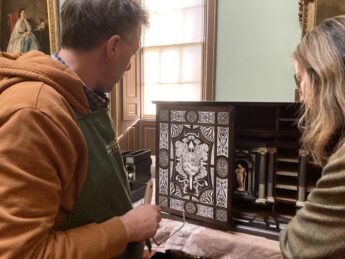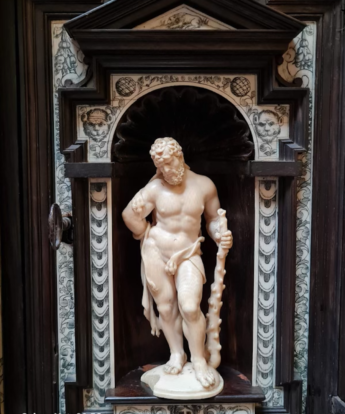Restoring The Hercules Cabinet

Right at the end of our visitor season in 2023, visitors to our Regency Picture Gallery were lucky enough to encounter a restoration-in-action project. Fergus Purdy, a highly skilled conservationist who has worked on parts of our collection recently with grant-funding support, was restoring The Hercules Cabinet and chatting to visitors about his work. This is one of the oldest pieces of furniture in the Paxton House collection, in fact it is nearly two hundred years older than the house itself, made between 1590 and 1620.
We are currently researching details of its history and origins but we know a little already. This beautiful rosewood and ivory cabinet was bought by Patrick Home, the builder of Paxton House, on one of his trips to Italy between 1751 and the late 1770s. Half a century later, Patrick’s cousin, George Home, who inherited it in the 1790s, commissioned a stand for it.
 The cabinet is a particularly fine example of a type which was very fashionable with the aristocratic families of Central and Northern Italy in the Renaissance. It was probably made in Naples which was a centre for this type of work. We believe it belonged to the Albertoni family of Milan and Cremona based on the coat of arms emblazoned on both doors. Cabinets of this type were designed not just for keeping precious objects, but for their display to a selected few guests of the owner. As such they conveyed clear messages about the owner’s education and knowledge of classical culture, important attributes of the Renaissance prince. Typical objects might include Greek and Roman coins and medallions, precious stones and small religious objects. Curiosities from natural history might also be included, demonstrating the Renaissance man’s curiosity about the world. Their private nature – there are a series of secret drawers in our cabinet – added cachet and further status to the sharing of the secrets of the cabinet with a few select guests. The greek hero and demi-god, Hercules, appears in an exquisite ivory statuette at the heart of the cabinet while his life and achievements are celebrated in a series of small incised plaques set into the drawers. The character of the legendary Hercules would perfectly suit a Renaissance nobleman as an architype – manly, strong and invincible.
The cabinet is a particularly fine example of a type which was very fashionable with the aristocratic families of Central and Northern Italy in the Renaissance. It was probably made in Naples which was a centre for this type of work. We believe it belonged to the Albertoni family of Milan and Cremona based on the coat of arms emblazoned on both doors. Cabinets of this type were designed not just for keeping precious objects, but for their display to a selected few guests of the owner. As such they conveyed clear messages about the owner’s education and knowledge of classical culture, important attributes of the Renaissance prince. Typical objects might include Greek and Roman coins and medallions, precious stones and small religious objects. Curiosities from natural history might also be included, demonstrating the Renaissance man’s curiosity about the world. Their private nature – there are a series of secret drawers in our cabinet – added cachet and further status to the sharing of the secrets of the cabinet with a few select guests. The greek hero and demi-god, Hercules, appears in an exquisite ivory statuette at the heart of the cabinet while his life and achievements are celebrated in a series of small incised plaques set into the drawers. The character of the legendary Hercules would perfectly suit a Renaissance nobleman as an architype – manly, strong and invincible.

In the 18th century, cabinets like this one, became highly desirable for young men on Grand Tour from Britain in search of souvenirs and objects which would prove the sophistication of their tastes when they returned home. It would have been a prized purchase for Patrick Home and an equally prized inheritance for George Home half a century later. In 1814, George corresponded with the English miniaturist George Perfect Harding about the possibility of getting a stand made. We know nothing more about the stand’s manufacture but it is made of ebony and ivory with renaissance-style grotesque patterns that pick up the design of the cabinet.
The Hercules Cabinet is now looking as good as it did when it was first made and we fully expect it to survive for another four hundred years. You can see it on a tour of Paxton House when the house reopens in April or on one of our special Behind the Scenes tours this winter.
Read more about this exciting project here.
The restoration project was made possible thanks to the Pilgrim Trust and an anonymous donation.
